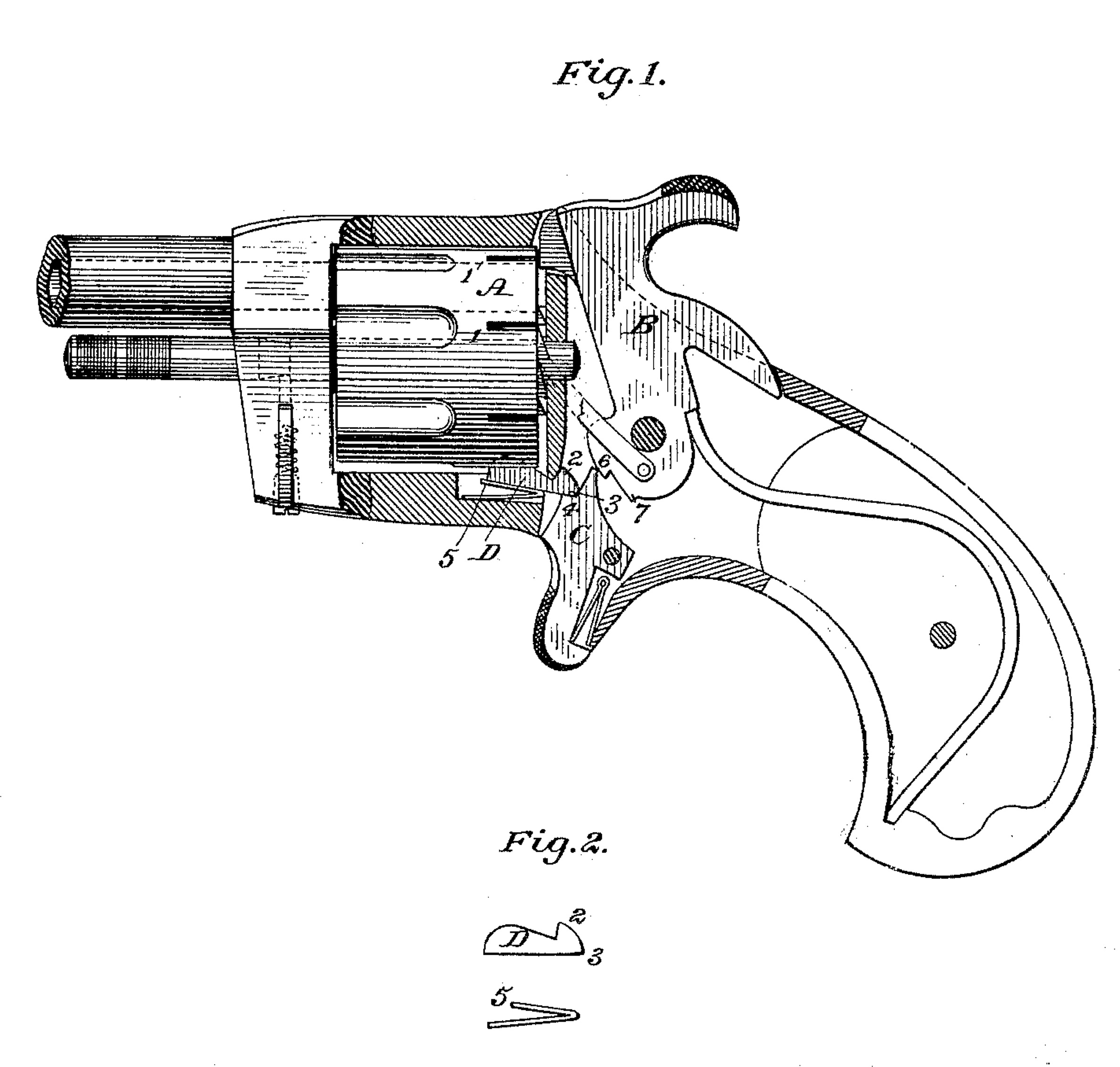US 239821
UNITED STATES PATENT OFFICE.
HENRY McGEE, OF NORWICH, CONNECTICUT, ASSIGNOR TO HIMSELF AND FREEMAN W. HOOD, OF SAME PLACE.
CYLINDER-STOP FOR REVOLVING FIRE-ARMS.
SPECIFICATION forming part of Letters Patent No. 239,821, dated April 5, 1881.
Application filed February 17, 1881. (No model.)
To all whom it may concern:
Be it known that I, HENRY McGEE, of Norwich, in the county of New London and State of Connecticut, have invented a new and useful Improvement in Revolvers; and I do hereby declare that the following is a full, clear, and exact description of the same.
My invention is an improvement upon the patent granted December 10, 1878, to A. L. Sweet. In that patent was shown a revolver wherein the cylinder was kept from revolving by a stop pivoted to the trigger and working in a slot in the bottom of the chamber which contained the cylinder, the cylinder being provided with corresponding slots into which the stop projected.
The object of my invention is to simplify the construction and lessen the cost and labor of manufacture; and it consists in the peculiar construction and arrangement of the stop and the parts that operate in connection therewith, as fully hereinafter described.
In the drawings, Figure 1 is a central section of my pistol, and Fig. 2 is an enlarged detail view of the stop and spring.
In these drawings, A represents the cylinder of a revolver, and 1 1 slots on its surface, there being as many slots as there are chambers in the cylinder.
B is the hammer, and C the trigger, which are of the same general construction as it the patent referred to.
D is the stop. (Shown separately in Fig. 2.) Instead of being pivoted to the trigger, as it the patent referred to, the stop is provided with an offset, 2, which engages with the lower edge of the recoil-shield, and with a spur, 3, which rests on a projection, 4, on the upper forward end of the trigger. The bottom of the chamber which contains the cylinder is slotted, as shown, and in this slot the stop works, the lower edge of the recoil-shield serving as a fulcrum on which it swings. A spring, 5, serves to project the stop upward into its normal position when it enters one of the slots on the cylinder, and holds it stationary. The offset 2 holds the stop in position against any longitudinal movement, and its rear end is held up by resting on the projection 4 of the trigger, so that it is secured against movement in any direction, except that necessary for its action, by means of its own construction, and that of the parts in connection with which it is placed.
It will be observed that the upper part of the trigger is bent forward. The projection 4 will therefore rise when the upper end of the trigger is thrown back; but the upper end of said trigger is kept in contact with the rounded edge of the hammer, and the construction of this part is such that it keeps the upper end of the trigger pressed forward far enough to permit the catch to be in gear with the cylinder at the proper time.
It will be understood that the spring 5 tends constantly to hold the catch in gear. The part of the hammer piece against which the upper end of the trigger bears when the hammer is low it, as in firing, allows the upper end of the trigger to come back far enough to let the spring 5 throw up the catch into gear with the barrel; but when the piece is at half-cock the spur or upper end of the trigger falls back into the notch 6, and in so moving throws up the rear end of the catch and depresses its front end sufficiently to release it, from the notch in the cylinder. As the hammer is drawn back the relative position of these parts is unchanged, and the catch is out of gear until the trigger engages with the notch 7 and is at full-cock, when the upper end of the trigger is thrown forward sufficiently to allow the spring 5 to throw the catch or stop into connection with the cylinder. The relative movement of the pawl is the same as usual.
It will be observed, from the description already given, that the same movement of the stop is caused by the described construction as that which has been accomplished heretofore by pivoting the catch upon the trigger.
Manifestly the construction is inexpensive, the stop being of such shape that it may be easily struck out, and there is a saving of the expense of pivoting this part upon the trigger.
It will be understood that the described construction is specially designed for revolvers of the less expensive class, although its efficiency is not less than that upon which it is an improvement.
Having thus described my invention, what I claim as new, and desire to secure by Letters Patent, is–
The described stop provided with an offset, 2, and spur 3, in combination with the trigger having projection 4, the recoil-shield, the edge of which acts as a fulcrum, and the spring 5, all substantially as described, and for the purpose set forth.
In testimony whereof I have signed my name to this specification in the presence of two subscribing witnesses.
HENRY McGEE
Witnesses:
CHAS. F. THAYER,
ALLEN BLACKWOOD.

